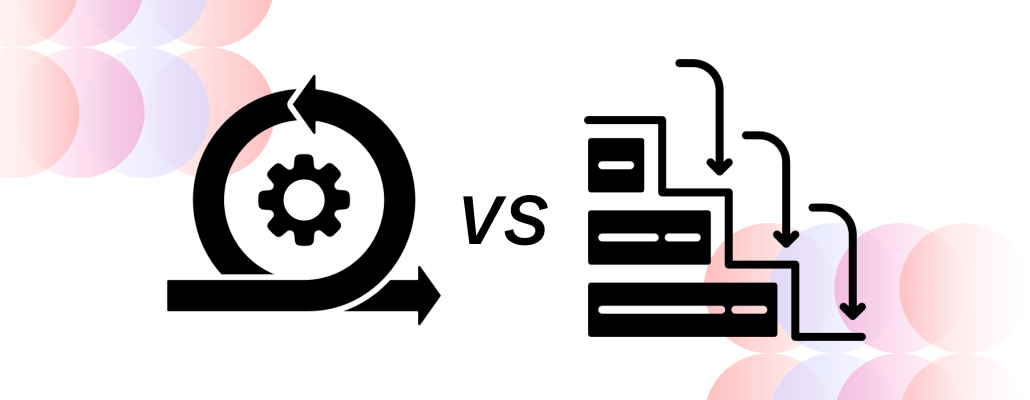Agile vs. Waterfall: Choosing the Right Approach for Product Development

In the world of software and product development, choosing the proper project management methodology is essential for success. Product development is the process of creating a new product or improving an existing one from concept to market launch. It involves a series of steps and activities aimed at bringing a product to market that meets customer needs and demands. The two most important methodologies are Agile and Waterfall, each with its particular approach and principles. The choice between these two approaches depends on the project's nature, requirements, and the organization's culture. This blog will explore the key differences between Agile and Waterfall and help you make an informed decision based on your specific needs.
Waterfall Methodology: A Sequential Approach
It follows a linear and sequential process with a series of distinct phases, each building on the previous one. The typical stages include requirements gathering, design, implementation, testing, deployment, and maintenance. However, once a step is complete, the development team moves on to the next one, and there is little room for revisiting earlier stages.
One of the advantages of it is its structured and well-defined process, making it easier to manage and plan. However, its rigidity can be a drawback, especially when dealing with evolving requirements. Hence, changes in the middle of the development process can be challenging to accommodate, and the entire project may need to restart again to implement modifications effectively.
Agile Methodology: Flexibility and Collaboration
On the other hand, it is an iterative and flexible approach that emphasizes adaptability to change. Agile divides the project into small increments, called iterations or sprints, each typically lasting two to four weeks. The development team works on small, functional increments and regularly collaborates with stakeholders to gather feedback. Hence, this feedback loop allows for continuous improvement and adjustments based on changing requirements.
Agile is suitable for projects where requirements are expected to evolve or where the end goals are not fully defined at the project's outset. It fosters collaboration, communication, and a customer-centric approach. Hence, Agile methodologies include Scrum, Kanban, and Extreme Programming (XP), each with its own set of practices and principles.
Choosing the Right Approach: Factors to Consider
The following factors are essential to consider while choosing the right approach:
Project Complexity and Size:
- Waterfall: Well-suited for smaller projects with precise and stable requirements.
- Agile: Ideal for complex projects where requirements are expected to evolve.
Flexibility and Adaptability:
- Waterfall: Less flexible; changes are difficult to implement once the project is underway.
- Agile: Embraces change and allows for flexibility in adapting to evolving requirements.
Client Involvement:
- Waterfall: Limited client involvement until the end of the project.
- Agile: Encourages constant client collaboration and feedback throughout the development process.
Risk Tolerance:
- Waterfall: Lower risk in terms of scope changes once the project begins.
- Agile: Embraces change, which may introduce uncertainty and risk but allows for quicker adaptation.
Testing and Quality Assurance:
- Waterfall: Testing is typically performed at the end of the development process.
- Agile: Testing is integrated throughout the development process, ensuring a focus on quality from the beginning.
Time-to-Market:
- Waterfall: May have a longer time-to-market due to its sequential nature.
- Agile: Supports quicker releases, allowing for a faster time-to-market.
Conclusion: Striking the Right Balance
In the Agile vs. Waterfall debate, there is no one-size-fits-all solution. The choice between these methodologies depends on the specific needs and characteristics of the project. However, some organizations even adopt a hybrid approach, incorporating elements of both methods to create a customized framework that suits their requirements.
A Waterfall approach may provide a straightforward and manageable process for projects with well-defined and stable requirements. However, in today's dynamic and rapidly changing business environment, where requirements are prone to evolve, Agile offers a more adaptive and customer-centric approach.
Ultimately, the key is to understand the nature of your project, the level of client involvement required, and the tolerance for change and uncertainty. However, by carefully considering these factors, you can decide whether to take a structured and sequential Waterfall path or embrace the flexibility and collaboration of Agile methodologies. Hence, the success of your product development hinges on aligning your chosen approach with the unique demands of your project and organization. For more latest blogs and information related to agile methodology in product development visit Tangent blogs.
